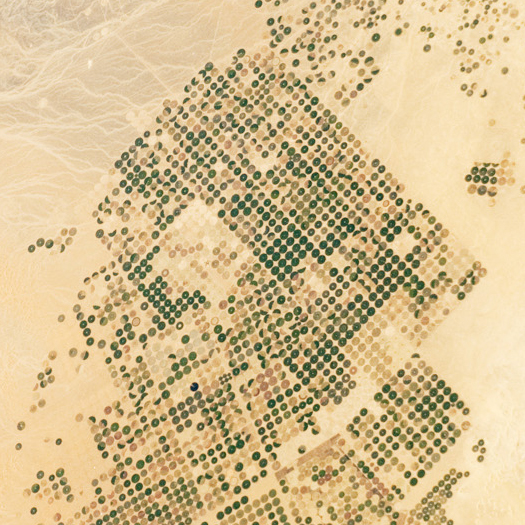
[A particularly stark example of the pixelated patterns produced by pivot irrigation, in northern Saudi Arabia. The patterns produced by irrigation in Saudi Arabia are so stark because what water is available in the Arabian penisula is buried as fossil waters at such great depths that wells may reach as much as three thousand feet below the surface, so that what water (and water-dependent vegetation) is present on land seems to have magically appeared in precise patterns (unlike, say, the great American pivot-fields over the Ogallala Aquifer, where irrigation is merely an overlay onto existing hydrology).
I’m reminded of a Der Spiegel article from a couple years ago, which told the story of a team of German geologists hired by the Saudi king to hunt ancient waters in the desert:
Fossil groundwater is the only natural water source in a region without rivers and lakes, where every raindrop is an event. After the last ice age, when the climate on the Arabian Peninsula was similar, in terms of temperature and precipitation, to that of savanna regions today, the water seeped away into the ground, eventually accumulating in hollow spaces between layers of sedimentary rock.
Most of this water is in eastern Saudi Arabia, precisely where most of the country’s oil and natural gas reserves are located. As a result, geologists searching for oil sometimes find water instead, or vice-versa. And like oil, the precious drops of water from the last ice age are finite. Too much of that water is now being pumped out of ever-deeper wells, causing the water table to drop. This in turn allows salt water to seep into the groundwater along the coasts.
In Wasia, 100 kilometers (63 miles) east of Riyadh, Rausch’s crew is drilling deep exploratory holes. Mario Rescia, managing director of Saudi drilling company Hajjan Drilling, is in charge of the pumping tests. Immigrant workers in yellow overalls and helmets work 12-hour shifts on the 27-meter drilling rig, at temperatures of up to 50 degrees Celsius — in the shade. “We do our best to help them stand it,” says Rescia. “There are refrigerators and drinks.”
And then, at his command, water suddenly starts bubbling out of the desert sand: clear, warm water, an amazing sight in a region that seems lifeless, aside from a few Bedouin and camels. The water is clean enough to drink, although it tastes a little stagnant — which is hardly surprising, given that it’s 25,000 years old.
The whole article is worth a read.
Image from NASA Earth Observatory, via @orangexception.]

